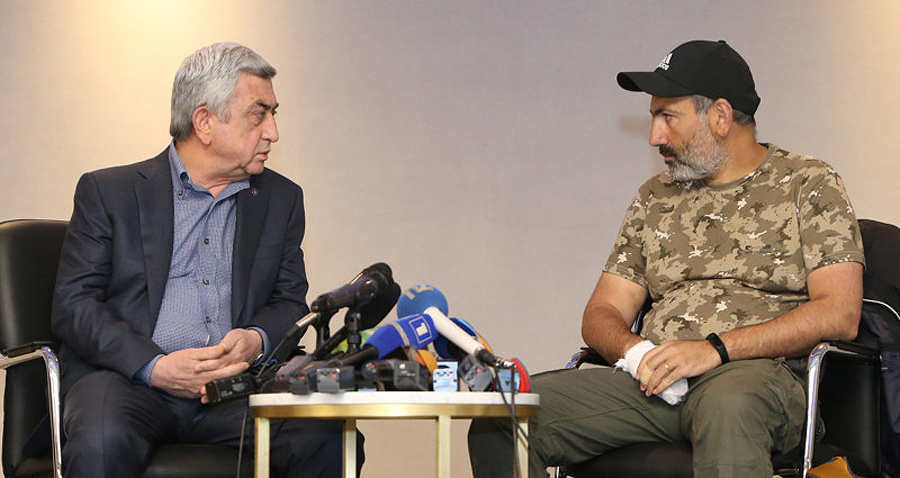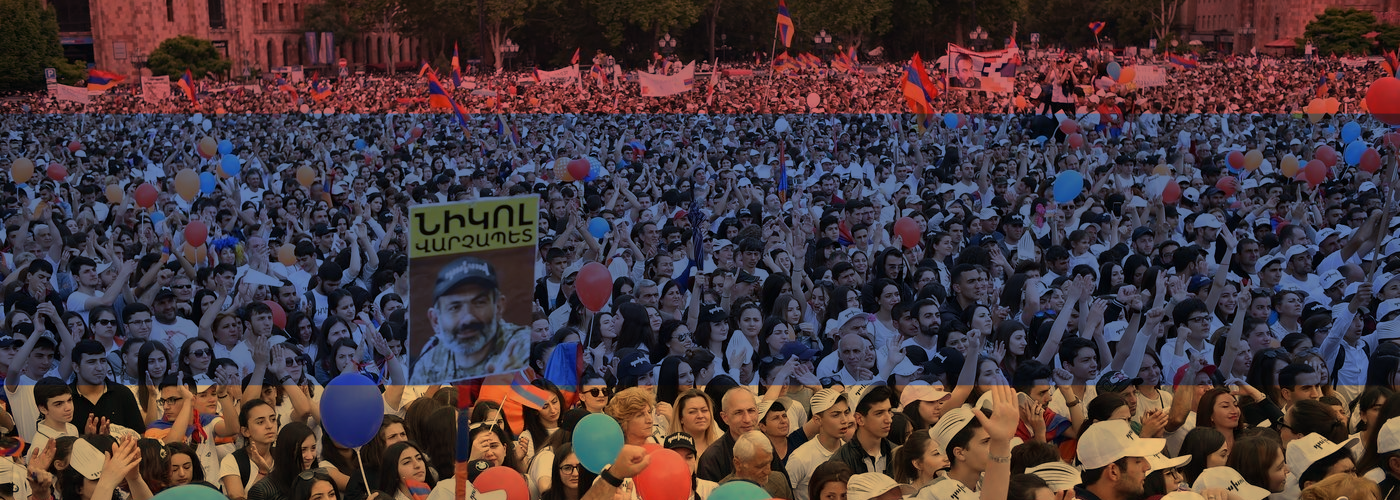
Table of Contents
The Velvet Revolution
Nikol Pashinyan
Im Kayl (My Step)
The Meeting
1 May
8 May
Conclusion
The “Velvet Revolution”
2018 Armenian “Velvet Revolution” was a series of anti-government protests in Armenia. The protests were initially against Serzh Sargsyan’s consecutive term as the most powerful figure in the government, later on against the Republican Party-controlled government. One of the important reasons for why the protests occurred is the low trust to the national government among country and confidence in judicial system. Which is below all of Armenia’s neighbours. In 2012-2017 reported levels of trust in the government was 25% while confidence in judicial system was 29%.
The revolution is most commonly known with the slogan “#MerzhirSerzhin” (#RejectSerzh) since the primary goal was the resignation of Serzh Sargsyan as Prime minister of Armenia.
Nikol Pashinyan
Nikol Pashinyan is the Prime Minister of Armenia, former journalist and editor. After the elections of 2008 in Armenia, he is appointed to have a significant role in the post-election protests which was put down by the government forces resulting in the death of 10 people. With the blame of “organizing mass disorder” he was sentenced to seven years of prison, a move that was mostly seen as political. He was elected to the parliament in 2012 from Ter-Petrosyan’s broad opposition coalition. Later on he separated from Ter-Petrosyan on political grounds and established the party Civil Contract. He was the leader of 2018 ‘Velvet Revolution’ in Armenia with the goal of removing Serzh Sargsyan from the seat of Prime Minister.
Im Kayl (My Step)
On 31 March 2018, Pashinyan began his “Im Kayl” (My Step) protest walk, in the city of Gyumri. He then walked through cities of Vanadzor, Dilijan, Hrazdan and Abovyan, before finally reaching Yerevan on 13 April and holding a small rally.
On 16 April, “Take a Step, Reject Serzh” campaign began actions of civil disobedience. On April 17, the day when Prime Minister elections were scheduled, the protesters acted to block the entrances of the National Assembly to prevent the election from taking place. Yet the police force managed to stop them from marching to the building.
Serzh Sargsyan was elected the new prime minister, while this caused massive increase in the protests. Despite the police forces detaining many people, thousands after thousands of people continued to protest. The President called for a meeting with the protests’ leader, Nikol Pashinyan, times after times, but Pashinyan said that he would discuss the resignation of Prime Minister, Serzh Sargsyan.
The Meeting

With the President visiting Pashinyan’s rally, Nikol said that he believed the topic would be Sargsyan’s resignation. The meeting lasted only three minutes, ended without any achievements. During the meeting, Sargsyan “warned” Pashinyan that he did not learn his lesson from “March 1”, where 10 people were killed by the government forces, meaning an open threat to all of the protesters gathering daily around the country.
Regardless, Pashinyan continued to walk and he went to the Republic Square, where they met riot police. The Police force detained Pashinyan, along with 232 protesters just until the day’s evening.
1 May
The Armenian Parliament held an election to select the new Prime Minister, with Pashinyan being the only candidate. However, the majority party, with only one exception, voted against his nomination. This blocked Pashinyan’s candidacy. After the elections, Nikol walked to Republic Square, told the crowd to gather new rallies.
As the next day came, the nation went on total civil blockation. The transportation had a stroke in the meantime. The opposition gathered another rally, with over 150.000 people listening to Nikol Pashinyan’s speech. He told that, due to the civil strike, the ruling party decided to support his candidacy on the next elections that were to be hold in 8 May.
8 May
In this repetition of vote, Pashinyan was, once again, the only nominee. This time, he had majority of Republican Party’s votes, although all of the votes against him came from the Republican Party at the same time.
Conclusion
Overally, the Armenian “Velvet” revolution and its results are overwhelmingly surprising. Sargsyan, in the past, managed to suppress civil unrest. But, in the span of weeks, Sargsyan and his party was completely removed from power. It differs from the past colour revolutions we saw in Eurasia with many points. These colour revolutions (like the most current ones in Belarus) are mostly concentrated in the results of elections. But this, “Armenian Velvet” revolution concentrated on Sargsyan’s desired passage into a parliamentary system, from a semi-presidential one.
Another point is that, colour revolutions are mostly centered around NGOs (Non-Governmental Organisations) or by other words, Civil Society Organisations. However, Armenian revolution was characterized by the active usage of social media by the opposition. But this has historical and cultural reasons. Since the collapse of the Soviet Union and independence of Armenia, Armenian society has been more of a protest-based civil society than an organization-based one. The reason for this is that NGOs have a very poor reputation in the country; according to the Caucasus Barometer, trust in NGOs has been around 22% for the past decade. Especially after the 2008 protests, it seemed like the Armenian nation believed protest was the only way to be politically active.
What the Velvet revolution provided for Armenians was, that they could participate without having to march, with actions such as by honking during their commute and banging pots and pans at night to indicate their support.
The question that’s a must to ask, is that what the Velvet revolution proposed specifically for the economical conditions of Armenians. Nothing. Some give this as a severe critique, some defend that by saying the campaign was focused around the removal of Sargsyan. However, as a matter of fact, the Velvet revolution led by Pashinyan proposed “nothing” in terms of economy, diplomacy and other state affairs. Even after the revolution, conflicts with neighbours, the “Russia question”, corruption and economic discontent remains in the agenda of Armenian government and society. It is unknown what will the government of Pashinyan produce as a solution to these issues.
However, it is, as cited by many academicians and commentators, important to understand the political atmosphere before and after the Armenian Velvet revolution to understand the internal politics of post-Soviet countries and their colour revolutions. This ‘Velvet Revolution’ will be an interesting example for the movements with same intentions.


